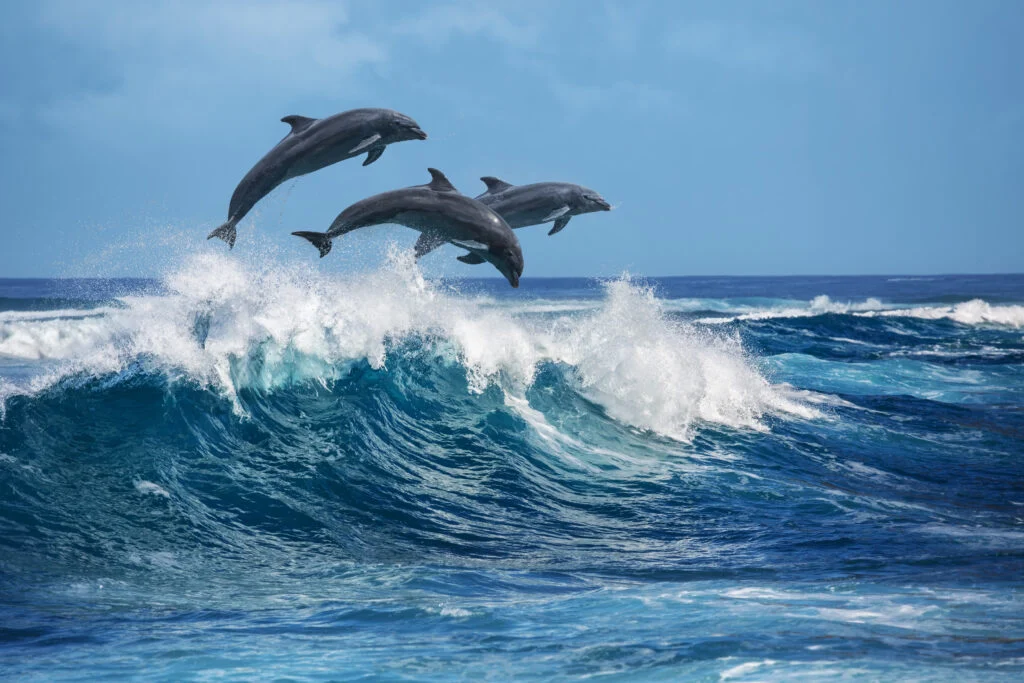Introduction
Dolphins are among the most intelligent and social creatures in the ocean. Known for their playful behavior and remarkable navigation skills, they inhabit various marine environments around the world. This exploration delves into their biology, behavior, navigation abilities, and conservation challenges.
1. Dolphin Species and Characteristics
A. Diversity of Species
- Different Types: There are over 40 species of dolphins, including the bottlenose dolphin, common dolphin, and orca (often called a “killer whale”). Each species has unique traits and adaptations.
- Physical Features: Dolphins typically have streamlined bodies, a dorsal fin, and a beak-like snout. Their skin is smooth and often varies in color, usually shades of gray or blue.
B. Size and Lifespan
- Size Range: Dolphins can range from the small Hector’s dolphin (about 4.5 feet long) to the large orca, which can grow up to 32 feet.
- Lifespan: Depending on the species, dolphins can live anywhere from 20 to over 60 years in the wild.
2. Social Structure and Behavior
A. Social Animals
- Pod Life: Dolphins live in groups called pods, which can consist of just a few individuals or up to several hundred. These pods are often family units, providing support and protection.
- Communication: Dolphins communicate using a variety of sounds, including clicks, whistles, and body language. Each pod may develop unique vocalizations, similar to dialects.
B. Playful Nature
- Playful Behavior: Dolphins are known for their playful antics, including surfing on waves, leaping out of the water, and playing with seaweed or other objects. This play is not only fun but also helps strengthen social bonds within the pod.
3. Navigation Skills
A. Echolocation
- Biological Sonar: Dolphins use echolocation to navigate and hunt in dark or murky waters. They emit sound waves that bounce off objects, allowing them to determine distance, size, and shape.
- Advanced Adaptations: Their ability to process these sounds quickly enables them to locate prey and avoid obstacles with remarkable accuracy.
B. Environmental Awareness
- Understanding Currents: Dolphins are adept at reading ocean currents and using them to their advantage while traveling long distances. They can sense changes in water temperature and salinity, which may indicate the presence of food.

4. Feeding Habits
A. Diet
- Carnivorous Diet: Dolphins primarily feed on fish, squid, and crustaceans. Their diet varies depending on the species and availability of prey.
- Hunting Techniques: Dolphins employ various strategies for hunting, including cooperative hunting where groups work together to herd fish into tight balls for easier feeding.
B. Tools and Techniques
- Tool Use: Some dolphin species, like the bottlenose dolphin, have been observed using marine sponges to protect their snouts while foraging on the seafloor.
5. Conservation Status
A. Threats to Dolphins
- Human Impact: Dolphins face numerous threats, including habitat loss, pollution, entanglement in fishing gear, and hunting. Coastal development can also disrupt their habitats and feeding grounds.
- Climate Change: Rising ocean temperatures and changes in sea levels affect dolphin prey availability and migration patterns.
B. Conservation Efforts
- Protected Areas: Many countries have established marine protected areas (MPAs) to safeguard dolphin habitats and promote conservation.
- Research and Awareness: Organizations work to raise awareness about the importance of dolphins in marine ecosystems and promote responsible tourism practices.
6. Dolphins and Humans
A. Cultural Significance
- Myths and Stories: Dolphins have been featured in various cultures’ folklore, often symbolizing intelligence, playfulness, and friendship.
- Therapeutic Benefits: Dolphin-assisted therapy has gained popularity, with some programs claiming benefits for individuals with disabilities. However, this practice remains controversial and requires careful consideration of animal welfare.
B. Ecotourism
- Dolphin Watching: Ecotourism has grown around dolphin watching, providing opportunities for people to observe these amazing creatures in their natural habitat. Responsible practices are crucial to minimize stress on dolphin populations.
Conclusion
Dolphins are truly nature’s playful navigators, showcasing remarkable intelligence, social complexity, and adaptability. As we continue to learn more about these incredible creatures, it is vital to support conservation efforts to protect their habitats and ensure their survival. By fostering a deeper understanding of dolphins and their role in the marine ecosystem, we can work towards a future where they thrive in healthy oceans.
Further Reading and Resources
- Books: “Dolphins: The Animal Answer Guide” by Janet Mann provides insights into dolphin behavior and biology.
- Websites: Organizations like the Dolphin Research Center and the Oceanic Society offer resources on dolphin conservation and research efforts.



